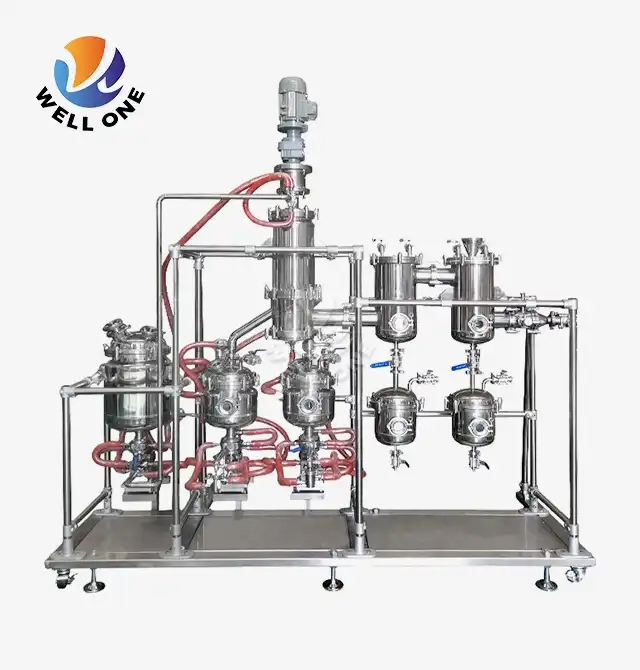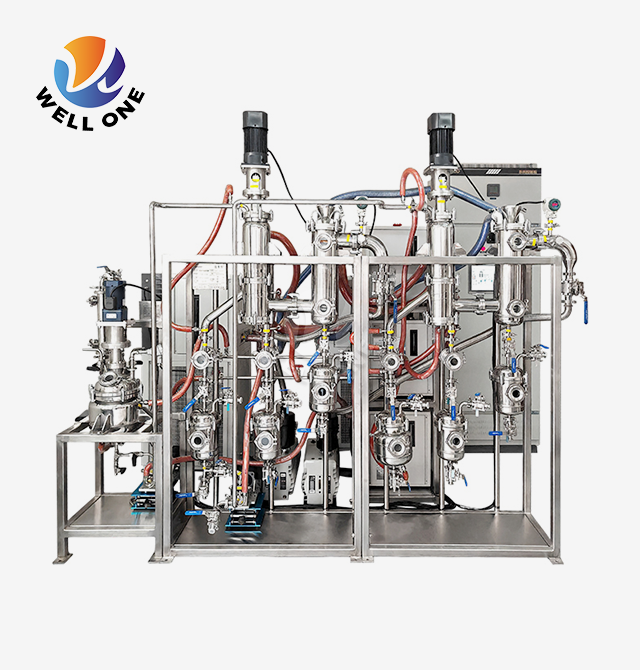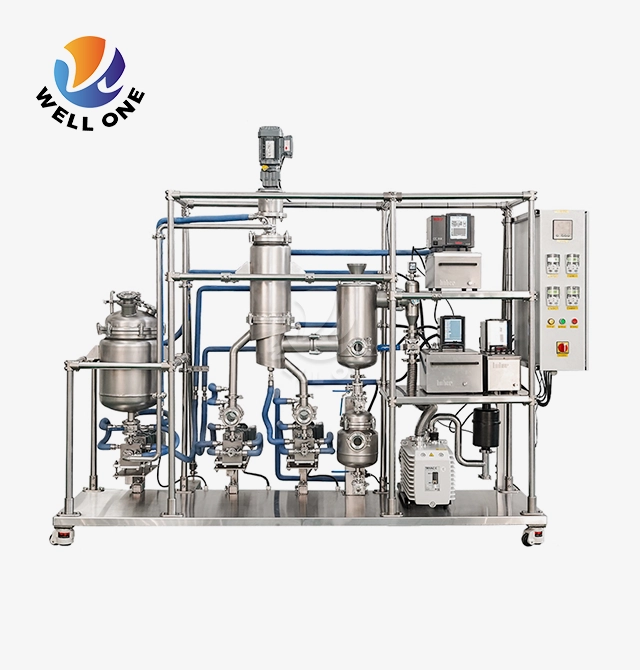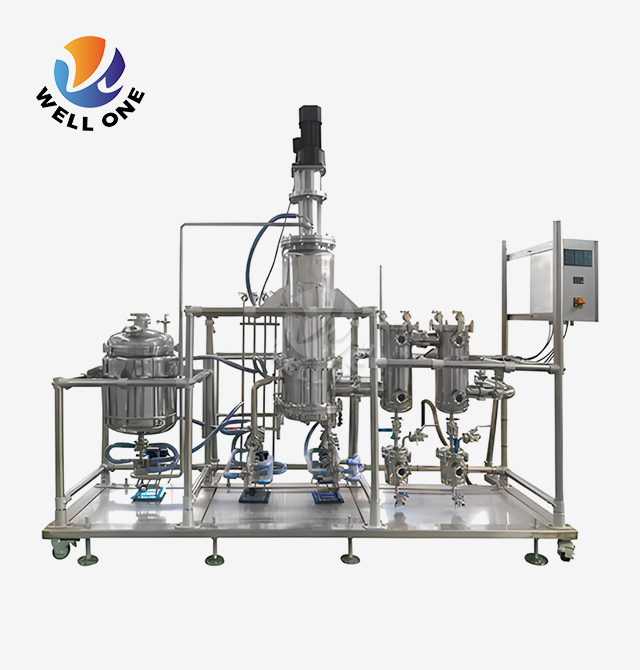What Temperature and Pressure Ranges Can an Agitated Thin Film Evaporator Handle?
Agitated thin film evaporator are versatile equipment utilized across diverse industries for evaporation, distillation, and concentration processes. These systems play a crucial role in applications ranging from pharmaceuticals and chemicals to food processing and environmental remediation. Understanding the temperature and pressure ranges that Agitated thin film evaporator can handle is fundamental to optimizing performance and ensuring safe operations.
Understanding Agitated Thin Film Evaporators
An agitated thin film evaporator consists of a cylindrical evaporator body, an agitator mechanism, a heating jacket, and a condenser. The key principle behind Agitated thin film evaporator is the creation of a thin film of liquid on the heated surface, which enhances heat transfer and minimizes residence time. This feature makes Agitated thin film evaporator suitable for processing heat-sensitive materials, as it reduces the risk of thermal degradation.
The agitator mechanism, typically a rotor with scraper blades or wiper blades, ensures uniform distribution of the liquid film on the heated surface. This improves heat transfer efficiency and prevents fouling or buildup of residues. The heating jacket provides the necessary thermal energy to facilitate evaporation, while the condenser captures and recovers the vapor generated during the process.
Temperature Range for Agitated thin film evaporator Operation
Agitated thin film evaporator can effectively operate within a wide temperature range, typically spanning from ambient temperatures up to 350°C (662°F) or higher, depending on the materials being processed and the specific design of the equipment. Factors influencing temperature control in Agitated thin film evaporator include the heating medium used (e.g., steam, thermal fluid, or electrical heating), the desired residence time, and the compatibility of the materials with the operating temperatures.
Higher temperatures generally increase the evaporation rate by raising the vapor pressure of the liquid being processed. However, excessively high temperatures can lead to thermal degradation, fouling, or other undesirable effects, particularly for heat-sensitive materials. On the other hand, lower temperatures may result in slower evaporation rates and longer residence times, potentially affecting process efficiency.
Pressure Range for Agitated thin film evaporator Operation
Agitated thin film evaporator can handle a broad range of pressures, including both vacuum and positive pressure conditions. Typical operating pressures range from atmospheric pressure down to sub-atmospheric pressures as low as 0.001 mbar or lower. This versatility in pressure control allows Agitated thin film evaporator to be employed in various applications, such as solvent recovery, concentration of heat-sensitive compounds, and the removal of volatile components.
Working under vacuum conditions can lower the boiling point of the liquid, facilitating evaporation at lower temperatures and reducing the risk of thermal degradation. Conversely, operating at positive pressures may be necessary for specific applications, such as processing materials with high boiling points or handling hazardous substances.
Influence of Temperature and Pressure on Evaporation Efficiency
Temperature and pressure settings significantly impact the evaporation efficiency and overall performance of Agitated thin film evaporator. Higher temperatures generally increase the vapor pressure of the liquid being evaporated, thereby enhancing the evaporation rate. Similarly, lower pressures reduce the boiling point of the liquid, facilitating evaporation at lower temperatures. By optimizing these parameters, Agitated thin film evaporator can achieve efficient evaporation while minimizing thermal stress on the processed materials.
However, it is crucial to strike a balance between temperature, pressure, and residence time to prevent excessive thermal exposure or undesirable side reactions. Careful monitoring and control of these parameters are essential to ensure product quality, process efficiency, and overall safety.
Material Compatibility and Thermal Sensitivity
When selecting temperature and pressure ranges for Agitated thin film evaporator operations, it is crucial to consider the thermal sensitivity and compatibility of the processed materials. Some materials may be prone to degradation, fouling, or other undesirable effects at elevated temperatures or extreme pressures. Examples of heat-sensitive materials commonly processed in Agitated thin film evaporator include pharmaceutical compounds, biopharmaceuticals, food ingredients, and certain specialty chemicals.
Thermal degradation can lead to changes in the chemical structure, loss of biological activity, or formation of undesirable by-products, compromising product quality and safety. Additionally, some materials may undergo polymerization, oxidation, or other reactions when exposed to high temperatures or specific pressure conditions.
To mitigate these risks, it is essential to thoroughly understand the thermal stability and reactivity profiles of the processed materials. Conducting compatibility studies, employing analytical techniques (such as differential scanning calorimetry and thermogravimetric analysis), and consulting relevant literature and databases can provide valuable insights into the appropriate temperature and pressure ranges for specific materials.
Process Optimization and Scale-Up Considerations
Optimizing Agitated thin film evaporator processes often involves adjusting temperature and pressure parameters to achieve desired outcomes, such as maximizing evaporation rates, improving product quality, or minimizing energy consumption. However, scaling up Agitated thin film evaporator operations from laboratory or pilot-scale to industrial production can introduce challenges related to heat transfer, residence time, and material handling. Thorough process validation and careful consideration of scale-up factors are necessary to ensure consistent performance across different production scales.
During scale-up, maintaining uniform heat transfer and consistent residence times can become more challenging due to factors such as increased surface area, altered flow patterns, and potential fouling or clogging. Additionally, the heat load requirements and heat transfer coefficients may change, necessitating adjustments to temperature and pressure settings.
To address these challenges, computational fluid dynamics (CFD) simulations and scale-up methodologies can be employed to predict heat transfer and fluid flow patterns, identify potential hot spots or dead zones, and optimize equipment design and operating parameters. Pilot-scale trials and rigorous process validation are also essential steps before transitioning to full-scale production.
Safety Measures and Regulatory Compliance
Operating Agitated thin film evaporator at high temperatures and pressures poses potential risks, including equipment failure, leaks, and personnel exposure to hazardous conditions. Implementing appropriate safety measures and adhering to regulatory requirements and industry standards are crucial for ensuring safe operation and personnel protection. These measures may include pressure relief systems, temperature monitoring and control systems, personal protective equipment, and rigorous training programs.
Pressure relief systems, such as rupture discs or relief valves, are essential to prevent excessive pressure buildup and mitigate the risk of equipment failure or explosions. Temperature monitoring and control systems, including temperature sensors and automated control loops, help maintain the desired operating temperatures and prevent overheating.
Personal protective equipment (PPE), such as heat-resistant gloves, face shields, and protective clothing, should be worn by personnel working with Agitated thin film evaporator to prevent exposure to high temperatures, pressures, or hazardous materials. Regular equipment inspections, maintenance, and testing are also critical to ensure the safe operation of Agitated thin film evaporator systems.
Compliance with relevant regulations and industry standards, such as those set by organizations like the Occupational Safety and Health Administration (OSHA), the Environmental Protection Agency (EPA), and the International Organization for Standardization (ISO), is essential. These guidelines cover aspects such as equipment design, material compatibility, process safety management, and environmental protection.
Case Studies and Applications
Agitated thin film evaporator finds applications in various industries due to its ability to handle a wide range of temperatures and pressures. In the pharmaceutical industry, Agitated thin film evaporator is used for concentrating and purifying active pharmaceutical ingredients (APIs) while minimizing thermal degradation. This is particularly important for heat-sensitive compounds, such as proteins, peptides, and certain small molecules.
In the chemical industry, Agitated thin film evaporator is employed for solvent recovery, concentration of specialty chemicals, and removal of volatile organic compounds (VOCs). For example, Agitated thin film evaporator can be used to recover and concentrate valuable solvents from reaction mixtures or purify chemical intermediates while removing unwanted volatile components.
Food processing applications include concentration of fruit juices, evaporation of whey and other dairy products, and purification of edible oils. Agitated thin film evaporator's ability to operate at low temperatures and pressures helps preserve heat-sensitive nutrients, flavors, and functional properties of food ingredients.
Environmental remediation and waste treatment processes also benefit from Agitated thin film evaporator technology. These systems can be employed for the concentration of wastewater streams, recovery of valuable components, or removal of volatile organic compounds (VOCs) from contaminated air streams.
In the biopharmaceutical industry, Agitated thin film evaporator plays a crucial role in the purification and concentration of therapeutic proteins, vaccines, and other biological products. The precise temperature and pressure control capabilities of Agitated thin film evaporator minimize the risk of product degradation or denaturation, ensuring the maintenance of biological activity and structural integrity.
Conclusion
Agitated thin film evaporators are capable of operating within a broad range of temperatures and pressures, making them highly versatile and adaptable for various evaporation, distillation, and concentration processes. Understanding and controlling these parameters is paramount for optimizing process efficiency, ensuring product quality, and maintaining safe operations. By carefully considering material compatibility, thermal sensitivity, and process requirements, manufacturers can leverage the full potential of Agitated thin film evaporator to achieve desired outcomes while adhering to industry standards and regulatory guidelines.
Xi'an Well One Chemical Technology Co., Ltd is a leading provider of chemical equipment solutions with 17 years of experience. Our team of experts is dedicated to researching and producing innovative synthesis and purification separation equipment, and we offer comprehensive services to our customers. We provide a range of products such as molecular distillation devices and multi-level continuous-use systems, and our Agitated Thin Film Evaporator is a popular product. To learn more, visit our website or contact our sales team at Mobile: (+86) 18191320360 or Email: info@welloneupe.com.
References:
1. Billet, R. (Ed.). (2013). Evaporators: Theory and Practice. Springer Science & Business Media.
2. Harbert, V. D. (2021). Thin Film Evaporators: Theory, Design, and Operation. Wiley-VCH.
3. Gerhart, P. M., Gross, R. J., & Hochstein, J. I. (2017). Fundamentals of Fluid Mechanics. Pearson.
4. Sinnott, R. K. (2005). Chemical Engineering Design (Vol. 6). Butterworth-Heinemann.
5. Seider, W. D., Lewin, D. R., Seader, J. D., Widagdo, S., Gani, R., & Ng, K. M. (2009). Product and Process Design Principles: Synthesis, Analysis and Evaluation. Wiley.
6. Singh, R. P., & Heldman, D. R. (2014). Introduction to Food Engineering. Academic Press.
7. Cussler, E. L., & Moggridge, G. D. (2011). Chemical Product Design. Cambridge University Press.
8. Wilkes, J. O. (2017). Fluid Mechanics for Chemical Engineers with Microfluidics, CFD, and COMSOL Multiphysics 5. Prentice Hall.
9. Rathore, A. S., & Kapoor, G. (2016). Process Validation in Manufacturing of Biopharmaceuticals. CRC Press.
10. Cheremisinoff, N. P. (2000). Handbook of Chemical Processing Equipment. Butterworth-Heinemann.







